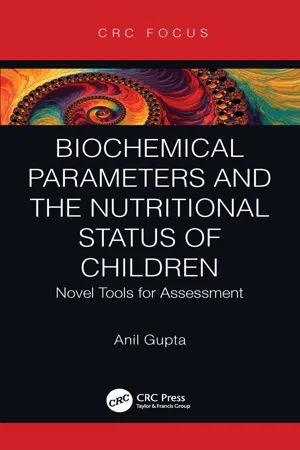Ancient Concept of Nutrition
The first dietary suggestion that was recorded in human civilization probably dates from around 2500 bce; in the form of a carving in Babylonian stone, and recommended abstaining from onions for three days so as to heal internal pain. This age-old advice was reported by Payne-Palacio and Canter (2014), who also discuss the 1500 bce description of scurvy found in the Ebers Papyrus.
Ayurveda—a traditional medicinal system that originated around 3,000 to 4,000 years ago in the Indian subcontinent—provides exhaustive narrations about food, health, and diseases. Ahara (nutrition) in Ayurveda is the cornerstone of body health and disease. Ahara is mentioned as one of the three prime concepts of life, the other two being sleep and controlled sexual life. In around 600 bce in the Sanskrit text Taittiriya Upanishad, Ahara (nutrition) had been described as Brahma (the creator of universe) owing to its prime essentiality in sustaining life. The energy for growth and development for living organisms is derived from food/Ahara (Nathani 2014).
Another Sanskrit text from around 600 bce, the Sushruta Samhita, mentioned elaborately the value of Ahara and dependency of human life on the correct Ahara (food) and Vihara (lifestyle) (Shastri 2003).
According to Gratzer (2005), a British biophysical chemist, the science of nutrition emerged around 600 bce. It was around this time that foods were classified in India, China, Persia, and Malaysia. Foods such as meat, ginger, blood, and spices were kept in the category of hot foods, while food items like green vegetables were mentioned as cold food by the author (Gratzer 2005).
According to Gratzer (2005), Ho, a physician in China around 600 bce, mentioned that deficiency of elements like water, wood, fire, metal, and earth in the body of individuals was responsible for the onset of diseases.
Furthermore, Gratzer (2005) reports the written account of a Greek, Alcmaeon of Croton, around 600 bce, in Italy. Alcmaeon mentions the importance of equilibrium between the intake of food and excretion of undigested matter from the body, which was important in deciding the health of a person and onset of a disease like obesity or wasting.
According to authors Gratzer (2005) and Smith (2004), in around 400 bce Hippocrates mentioned that food should be selected judiciously so that it may become medicine for the person, and that medicine ought to become food so as to normalize the pathological state of the person. Hippocrates advocated the prudent use of food and performing sufficient physical exercise to help prevent the onset of disease and obesity.
Medieval Concept of Nutrition
Galen was a famous physician of the gladiators in the Roman Empire, and also treated Marcus Aurelius, the emperor in Rome in around 130–200 ce (Gratzer 2005). Regarding nutrition, Galen mentioned the concept of “humors of body” of Hippocrates—black bile, yellow bile, phlegm, and blood, pertaining to four temperaments of individuals. These “humors” described the constitution of the human body and provided the basis for the medicinal system in Ancient Rome and Greece.
Galen described the concept of pneuma, a Greek word meaning soul or breath, which was considered the essence of life that pervaded in the body organs (Gratzer 2005).
Around 1500, Paracelsus and Leonardo da Vinci severely criticized the work of Galen (Gratzer 2005). British Navy physician James Lind was the first person who performed scientific work on nutrition. It was found that sailors who were at sea for prolonged periods suffered from a fatal disorder involving swollen gums, known as scurvy. It was James Lind who discovered that lime juice could cure patients from scurvy (Willet and Skerrett 2005).
According to Gratzer (2005), it was Antoine Lavoisier in around 1770 who described metabolism. He discovered that oxidation of foodstuff could generate energy. Antoine Lavoisier, along with his assistant Armand Seguin, estimated the respiratory output of carbonic acid in humans at rest and while lifting weights (Kenneth 2003; Seguin and Lavoisier 1789).
In 1816, French physiologist and surgeon François Magendie conducted his famous experiments on dogs. He used a nutritious food (sugar) to feed dogs. Initially, the first dog ate well for a period of two weeks and was healthy. Thereafter, a corneal ulcer developed in the dog and it lost weight (Magendie 1816; Kenneth 2003). It died after a month. The feeding experiment was repeated with a second dog, by providing a diet rich in olive oil, butter, or gum. The corneal ulcer was not observed in the dog that was fed olive oil, otherwise the dogs fell ill and died (Magendie 1816; Kenneth 2003).
Magendie demonstrated that a protein-deficient diet containing carbohydrates, lipids, and water could not save the dogs from starvation, while a diet enriched with proteins could prevent starvation and provide all the nutritional needs of the dog. The experiment proved the health benefits of proteins in the food for living organisms (Magendie 1816; Kenneth 2003).
According to Ahrens (1977), in 1827, it was English chemist William Prout who was the first person to propose the elements as carbohydrates, fat, and protein that are constituents of food.
In 1860, the French physiologist Claude Bernard demonstrated the glycogenic role of the liver that proved vital for the discovery of diabetes mellitus (Young 1957).
In the 1880s, Takaki Kanehiro (who served in the Imperial Japanese Navy as a physician) reported that some Japanese sailors developed beriberi disease. It was observed by Takaki that the sailors consumed white rice only as food and he concluded the disease to be associated with the intake of white rice. He confirmed that beriberi was unheard of among British sailors and naval officers in Japan due to their diet containing meat and vegetables (Bay 2012; Low 2005). However, physicians from Tokyo Imperial University declared beriberi as an infectious disease (Bay 2012; Low 2005).
